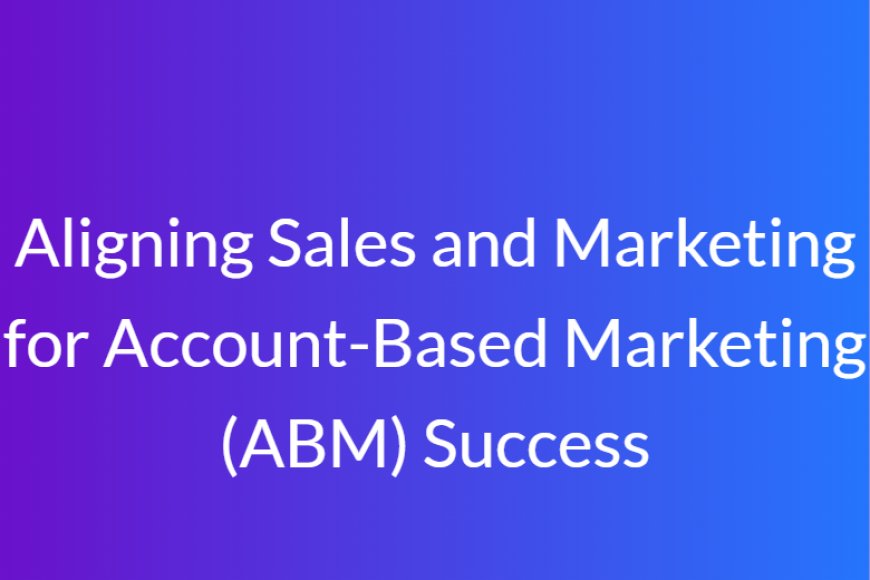Aligning Sales and Marketing for Account-Based Marketing (ABM) Success
Account-Based Marketing (ABM) thrives on alignment between sales and marketing especially when targeting high-value accounts.

Setting the Foundation for Collaborative ABM
thrives on alignment between sales and marketing especially when targeting high-value accounts. Unlike traditional campaigns where marketing hands off leads and moves on, ABM demands ongoing collaboration. Both teams must co-own strategy, messaging, and outcomes. This shared responsibility ensures that every touchpoint sent to target accounts is synchronized, personalized, and strategically timed.
When sales and marketing share a unified vision of which accounts are most attractive and what messaging resonates with each decision-maker, ABM becomes a seamless experience. Marketing provides the content and context, while sales delivers one?to?one conversations supported by that intelligence. The result is faster pipeline movement and stronger relationships hallmarks of Account-Based Marketing (ABM) success.
Unified Targeting: Choosing Accounts Together
Effective Account-Based Marketing (ABM) begins with a clear definition of target accounts, a decision that must be made jointly by marketing and sales. Marketing brings data-based insights ICP criteria, intent signals, website behavior while sales contributes relationship context and revenue expectations. This collaboration ensures that the list of accounts is not just theoretically a good fit, but also feasible to engage and convert.
When teams collaborate on account selection, they avoid wasted effort on accounts outside of both interest and intent. This creates a focused channel of engagement where every campaign, email, and conversation is tightly aligned with the specific needs of each account.
Persona Mapping to Drive Tailored Engagement
In Account-Based Marketing (ABM), it's not enough to target the account as a whole. Marketing and sales must map the organizations internal structure, identify the key personas, and tailor messaging accordingly. A good ABM playbook will map roles such as decision-makers, influencers, budget owners, and champions and create content tailored to each.
For example, an enterprise software vendor might develop persona-based messaging for CFOs (ROI and compliance), CIOs (integration, scalability), and department heads (user adoption, productivity benefits). By refining campaigns at the persona level, teams deliver highly relevant interactions across multiple stakeholders, increasing engagement and alignment.
Shared Content Calendars and Campaign Plans
To operationalize persona-driven engagement, Account-Based Marketing (ABM) teams build shared content calendars. These calendars organize when emails, direct mail, events, social ads, or webinars will reach target accounts. Collaboration tools help keep both sales and marketing visually aligned on messaging frequency, topics, and timing.
Shared calendars reduce overlap and increase efficiency. For instance, marketing may send an industry-specific case study to a target account the same week sales delivers a follow-up call referencing that content. When all engagement follows a unified plan, account interactions feel purposeful, thoughtful, and well-coordinated.
Coordinated Outreach: Timing is Everything
Timing is critical in Account-Based Marketing (ABM) engagements. Even the most compelling message risks falling flat if delivered awkwardly. Close collaboration ensures that marketing-generated touchpoints align with sales outreach efforts to avoid competing for attentionor worse, causing confusion.
For example, marketing might launch a direct mail piece one week followed by a personalized email from the salesperson reinforcing the message. If timed well, the sequence feels intentional and powerful. Conversely, misaligned timingsuch as marketing emailing too soon after a sales callcan frustrate prospects and dilute the conversation.
Sales Enablement: Empowering Reps with Context
One of the most effective ways to strengthen Account-Based Marketing (ABM) outcomes is equipping sales teams with marketing-supplied intelligence on target accounts. This can include:
-
Summary of recent activity (downloads, page visits)
-
Persona-specific talking points
-
Competitor intel and differentiation messaging
-
Customized content (ROI calculators, testimonials)
-
Suggested call-out strategies based on challenges
By centralizing this info in a sales enablement portal, reps can access and personalize materials quickly. This reduces preparation time and ensures that every outreach is relevant and informed. When sales puts these assets to use, ABM efforts feel professional, thoughtful, and strategic.
Nurture Flows Joined by Sales & Marketing
Account-Based Marketing (ABM) campaigns perform best when nurtured by both teams. Marketing sequencesemails, events, webinarsshould be supported by sales follow-ups triggered by prospect engagement. This combined outreach reinforces messaging and builds personal connections.
For example, after a prospect clicks through a case study email, a sales rep might send a personalized LinkedIn message referencing the same case study. This cohesive approach deepens engagement and creates a multi-channel experience that guides the account forward.
Performance Reporting: Joint Accountability
Transparency and shared reporting underpin strong Account-Based Marketing (ABM) execution. Rather than separate dashboards, marketing and sales review joint metrics: account engagement score, meeting volume, pipeline created, and deal wins. These shared metrics help create accountability and celebrate progress together.
When teams review results collaboratively, they can drill into whats workingand where adjustments are needed. Maybe a message angle resonates strongly with technology stakeholders, or a given channel outperforms others. Insights from these sessions feed into strategy refinements, content improvements, and operational tweaks that elevate ABM performance.
Running ABM Workshops and Training
To embed alignment in practice, many organizations run ABM workshops across sales and marketing. These sessions often explore:
-
ICP and account hand-off processes
-
Persona pain point exercises
-
Message testing per target role
-
Channel mix planning
-
Joint campaign scenario planning
-
Follow-through accountability sessions
Workshops build clarity and trust by breaking down silos. They also help new members understand how marketing and sales operate as a single ABM engineand what their joint role looks like from day one.
Tech Stack for ABM Collaboration
Tech plays a central role in ABM alignment. A well-integrated tech stack lets marketing and sales see the same signals in real timesupporting coordination, personalization, and orchestration.
Key platforms include:
-
CRM (Salesforce, Dynamics): Shared account records and activity logs
-
Marketing automation: Personalized campaigns tied to account actions
-
ABM platforms (6sense, Terminus, Demandbase): Intent data and multitouch orchestration
-
Sales enablement platforms (Seismic, Highspot): Ready access to content and playbooks
-
Communication tools (Slack, Teams): Real-time updates on engagement and next steps
-
Reporting dashboards (Tableau, Looker): Shared visibility into account metrics
When these tools talk to each other, ABM teams operate as one. Everyone sees the same account pulse and leverages that insight for better timing, messaging, and outreach.
Scaling Alignment Across the Organization
As ABM campaigns grow in volume and complexity, alignment becomes even more important. Scaling alignment requires:
-
Clear governance: Who leads account handoffs, messaging, approvals
-
Communication frameworks: Notifications when target account engages in key behaviors
-
Rolled-up visibility: Shared pipeline dashboards across departments
-
Strong feedback loops: Lightning-fast feedback from sales to marketing on messaging success and failure
-
Continuous training: Campaign retrospectives, playbook sharing, and best-practice refreshers
Strong alignment isnt just a nice-to-haveits essential to delivering high-touch personalization at scale.
Common Alignment Pitfalls and How to Fix Them
Account-Based Marketing (ABM) offers big rewards but alignment is not automatic. Common missteps include:
-
No-shared goal setting: Teams arent working toward the same KPIs
-
Siloed content creation: Marketing builds assets that dont resonate with sales
-
Poor communication: Sales reps arent informed of campaign schedules or assets
-
Misaligned timing: One team overruns on outreach that conflicts with other efforts
To fix these issues, accountability must be shared. Leaders should evaluate success by volume of collaborative activities (workshops held, accounts planned together), not just leads generated. Shared calendars, scheduled check-ins, and timely intel-sharing ensure campaigns are coordinated.
Read the Full Blog Now @ https://acceligize.com/featured-blogs/what-is-account-based-marketing-abm/
About Us
Acceligize is a global leader in B2B demand generation and sales enablement, specializing in connecting businesses with highly targeted, ready-to-engage prospects. Through innovative digital marketing strategies, buyer intent data, and multi-touch campaigns, Acceligize empowers sales and marketing teams to drive growth, generate qualified leads, and achieve faster revenue outcomes. With a focus on accuracy, engagement, and scalability, Acceligize delivers real, measurable results to enterprises across industries.































